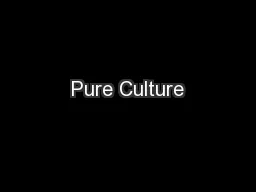

Pure Culture Techniques Turn on Incinerators and hot plates low heat Microbial Culture M ethod of multiplying microbial organisms by letting them reproduce in a predetermined culture media under controlled laboratory conditions ID: 589961
Download Presentation The PPT/PDF document "Pure Culture" is the property of its rightful owner. Permission is granted to download and print the materials on this web site for personal, non-commercial use only, and to display it on your personal computer provided you do not modify the materials and that you retain all copyright notices contained in the materials. By downloading content from our website, you accept the terms of this agreement.
Slide1
Pure Culture
Pure Culture Techniques
**
Turn on Incinerators and hot plates (low heat)
**Slide2
Microbial Culture
Method of multiplying microbial organisms by letting them reproduce in a predetermined culture media under controlled laboratory conditionsSlide3
Types of Media
Agar: jelly like substance derived from seaweed; thickening agent
We use agar because most microorganisms cannot digest agar so it provides a firm surface on which to grow and we can pick out individual coloniesBroth: liquid media (same as agar without the thickening agent) Slide4
Types of Agar
We can add specific ingredients to agar to grow or inhibit specific microorganisms
Selective: inhibit or help growth of certain organisms with the use of specific chemicalsDifferential: organisms produce characteristic changes or growth patterns dependent on the ingredients present
Supportive
: supports the growth of most organisms
Enrichment
: supplemented with
highly
nutritious materials that allow for the growth of fastidious (picky) organismsSlide5
Types of Agar
Tryptic Soy Agar (TSA) : Supportive media; general media used to grow most microorgansimsSlide6
Types of Agar
Eosin Methylene Blue (EMB): Selective and DifferentialSelects for Gram negative organisms (inhibits the growth of Gram Positive
organisms)Has Eosin Y and Methylene Blue- indicator dyes that react with any acidic products resulting from lactose fermentation to color the colonies
Lactose fermentation causes precipitation of the dyes on the surface of the colonies resulting in different colors-
Differential
Large amounts of acid → green metallic sheen
Small amounts of acid → pink
No fermentation → colorlessSlide7
Pure Cultures
Needed to identify bacteria and for antibiotic sensitivityCan be achieved by:
Pour platesIsolation StreaksSlide8
Pure Culture
Pour Plate: Serial dilution of the original sample is performed and a small amount of the final dilution is added to melted agar. The melted agar is poured into an empty sterile plate. Colonies will develop subsurface. Slide9
Pure Culture
Streak Plate
: the original culture is directly diluted across an agar surface using an inoculating loop
The
main idea
of a pure culture is
to dilute or thin out the original sample until the organism of interest is isolated and pure. Slide10
Making a Streak Plate Slide11
What do we need?
Split up into groups of 2 1 TSA plate/group
Mix 1 (Room Temp)1 EMB plate/group
Mix 2 (37°)
LABEL YOUR PLATES
Name/Initials
Class Section
Which mix you used Slide12
Exercise 6
Smear Preparation and Simple Staining Slide13
Smear Preparation
The way a smear is prepared will determine how well your stain will come out3 goals to a good smear
Making sure the cells adhere to the slide- heat fixInsure that shrinkage of the cells does NOT occur- distorts the cells, give improper representation of the cells shape/size-done by air-drying your slide before heat-fixPrepare a thin smear- thick smears make it harder to see individual cells and their arrangement, gives false staining resultsSlide14
Smear Preparation
Solid mediaAdd one drop of water to your slide
Use sterile inoculating needle to pick one colony- just a slight touch neededMix bacteria into water onto slide and try to spread out and thin as possibleLiquid media: no additional liquid is needed
Use a sterile loop, place a couple
loopfuls
of broth onto the slide- sterilize loop between touching the slide and dipping your loop
Place slide on heat plate to dry and heat fix smear (just until slide is completely dry)
Make sure you label your slide so you know which smear is which organismSlide15
Staining
Different types of Staining Simple Stain: use of a single stain to color a bacterial cell
Differential Stain: Use of a combinations of stains to differentiate between 2 or more organismsStructural Stains: stains only one part of a cell so it can be distinguished from the rest of the cell (ex: flagellar)
How do the stains work?
Biological Stains contain chromophores- chemicals that can impart color
A bacterial cell has slight over-all negative charge
Cationic/Basic Dyes: positively charged so it binds to the cell
Anionic/Acidic Dyes: negatively charged; repels the cells, stains everything else, results in a negative/indirect stainSlide16
Simple Stain
Uses only one colorCan only determine size and shapeSlide17
Differential Stain
Uses more than one color with a decolorization step between them
. (will do next lab)Slide18
Today’s Lab
Pure Culture-Split up into groups of 2
TSA (1/Group)Mix 1 (Incubates at Room Temp)
EMB (1/group) Mix 2 (Incubates at 37º)
Isolation Streak of the assigned mix on each plate
Smear Prep & Simple Staining
- On your own
Pseudomonas aeruginosa
in TSB
Staphylococcus aureus
on TSA
Stains:
Carbolfuchsin
: 1 min
Crystal Violet: 1
min
Safranin
:
15
min
Methylene Blue:
15
min Slide19
Lab
Work on your own. Each student to make:Smear of
Escherichia coli from TSB (tryptic soy broth)Smear of Staphylococcus aureus from TSA (tryptic soy agar)
Each of student in your row will use a different stain
Carbolfuchsin
: 1 min
Crystal Violet: 1 min
Safranin: 15 mins
Methylene Blue: 15 mins
Make notes of your observations; make sure you take a look at your fellow classmates slides to see the different stains
Record your observations on page 43